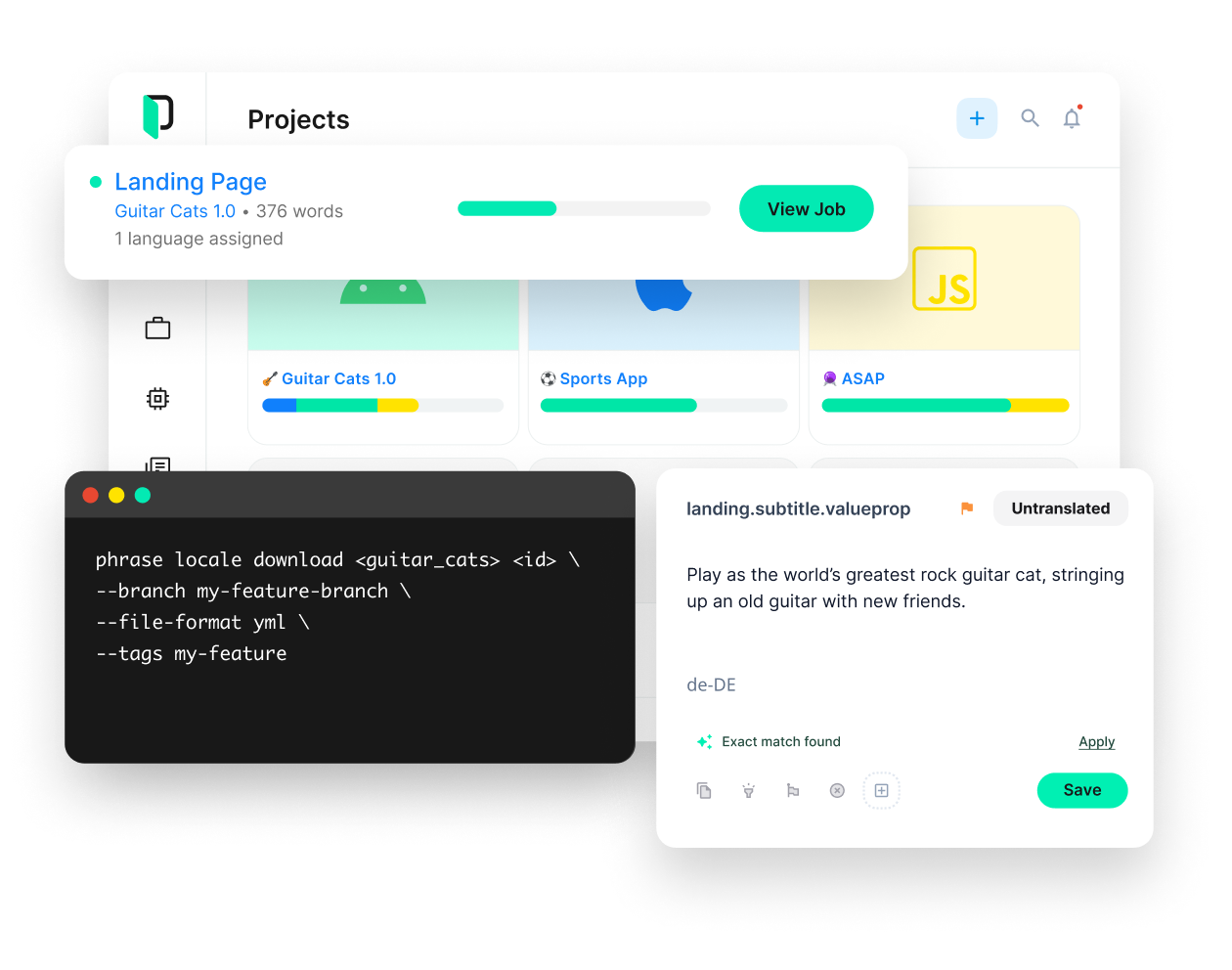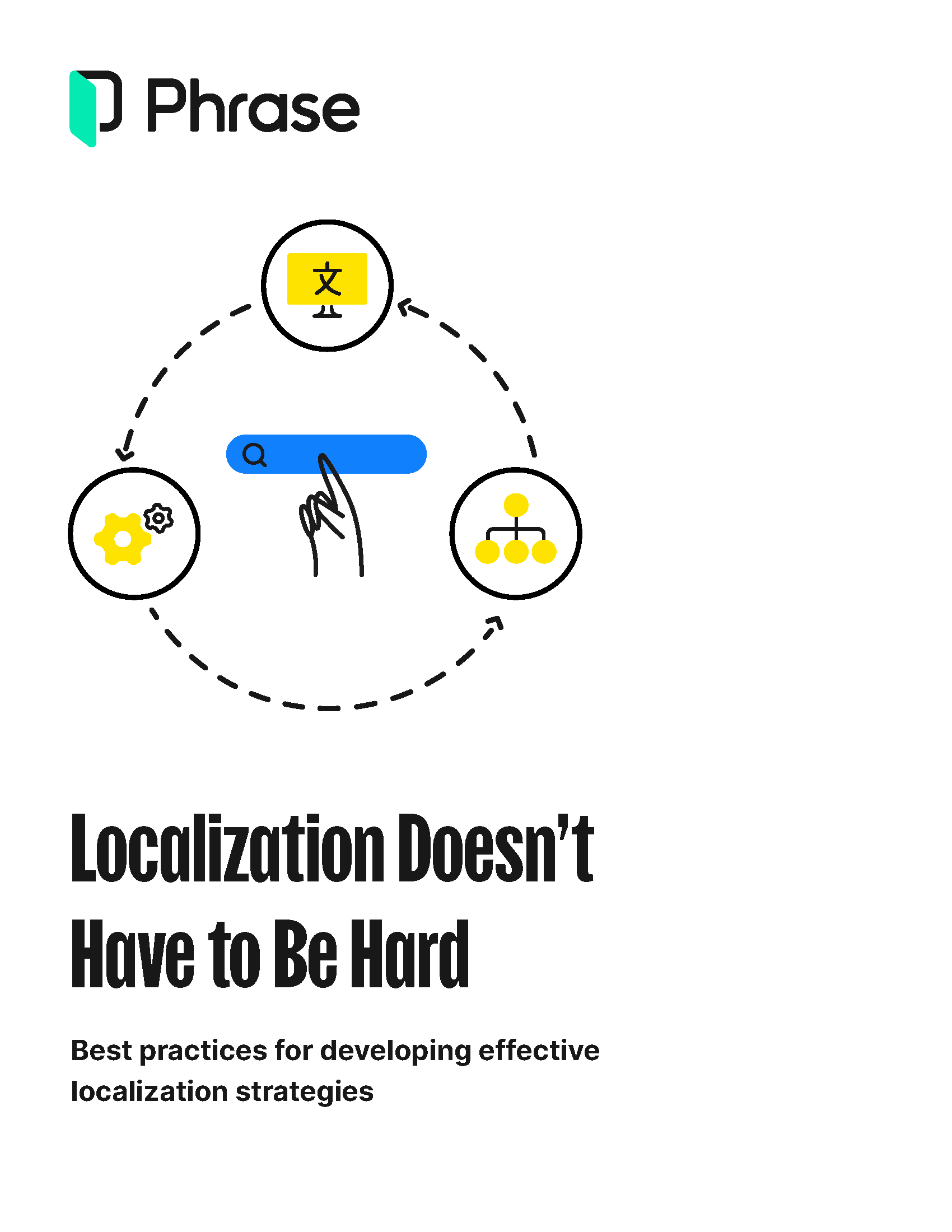Localization strategy
Software Localization Management Redefined: 3 Key Steps to Accelerate Global Growth

Software localization is key to the success of global software companies. At the frontline of driving growth across markets, localization managers are continually challenged to balance cost, scope, and speed to maintain translation quality. How do you overcome this constraint to ensure that your company deploys software localization as a lever for growth?
The answer often lies in adopting a proactive mindset to continually optimize your program. With a clear purpose, efficient workflows, and a technology partner that covers all localization needs across your organization, you can easily turn business goals into actionable localization plans. Keep reading to learn how to make the most of it for your software product.

Phrase Strings
Take your web or mobile app global without any hassle
Adapt your software, website, or video game for global audiences with the leanest and most realiable software localization platform.
Moving away from a fragmented function to a strategic focus on software localization
Not all localization is able to bring value to the business. That’s why successful software companies entrust localization managers with identifying where localization can help create revenue, foster customer loyalty, increase brand awareness, and more.
In other words, only a strategic focus on localization can make a difference in a software company’s bottom line.
Still, it can be difficult to realize the benefits if existing processes are ineffective. Accomplished localization managers always ensure that the right resources are applied to the highest-value projects, that manual processes are minimized, and that scalability is possible without sacrificing quality.
That’s why truly transformative localization rests on a clear purpose, efficient workflows, and powerful technology.
Let’s look in greater detail at these 3 essential steps for localization managers to turn their software localization program into a well-oiled machine capable of driving business results.
Set a clear purpose for software localization as a key part of the business strategy
To turn software localization into a strategic endeavor, a company needs to consider it integral to its overall business roadmap—not just a “nice-to-have” or an afterthought that gets tacked on at the end of the software development process.
This is possible by prioritizing business outcomes rather than only focusing on metrics such as word count or completed projects. Instead of considering mere project requirements, it’s key to tie your work back to business results and determine the most effective path to achieve them for all stakeholders involved.
Defining a clear purpose tied to specific key performance indicators (KPIs) relevant to the company—such as customer acquisition, customer engagement, or revenue growth—can help sharpen the focus of your software localization program.
While software localization strategies can vary between organizations, factors that are commonly considered include:
- Desired user experience: Organizations need to define their goals and understand the expectations of their target customers in order to align localization efforts accordingly. Increasing sales in a specific market, improving customer satisfaction, or smoothing the website journey based on local preferences are all examples of user experience goals.
- Supported languages: Supporting more languages increases the complexity of the localization process, as translations need to be maintained and updated. Companies should determine the languages necessary to reach their customer base and choose between “going wide” and “going deep”—i.e., expanding into multiple markets simultaneously vs establishing a strong presence in a few key markets before expanding further. Assessing if their current technology supports the required language support is also crucial.
- Resourcing limitations: Resourcing limitations, such as time, money, and human power, often constrain localization efforts. Realistic goals based on available resources help set expectations and allocate different levels of support to languages, projects, and initiatives. For example, the company can invest in human translation for important languages, opt for machine translation and post-editing for mid-tier languages, and use raw machine translation for less important languages.

Free download
Best practices for developing effective localization strategies
Explore how to tackle localization management efficiently and engage customers across the globe in their native languages and local experiences.
Refine the software localization process by implementing agile methodologies
Processes are like the keys on a piano. You can have a brilliant composition written down, but unless you hit the right keys in the right order and rhythm, you can’t create beautiful music. Similarly, manual workflows and inefficiencies can turn even the most carefully planned localization strategy into a mess.
That’s why your established workflow needs to run in parallel to software development cycles as much as possible. By employing an agile approach, you can quickly identify and fix problems and easily adapt to changes—resulting in faster turnaround times.
This change in paradigm will lead to localization management staying focused on removing the long-term obstacles to the software localization process rather than merely managing translation requests. The end goal is to make the localization process as least disruptive as possible.
The following steps can help you get there with confidence:
- Analyze your workflow: Look at your localization process as a flow of content and remove as many obstacles as you can before deploying it into production. If there are lots of difficulties, perhaps try a piecemeal approach. Find a workflow step where there is no obstacle, however small, and start there.
- Integrate and automate: Tight coupling is only possible if you automate as much of the translation process as possible. Sending files around and emailing people can be a waste of time and energy. Ideally, localization managers shouldn’t worry about batching up strings, transmit strings to translators manually, or reintegrate localized resources into the codebase. Once you have eliminated all the friction in the process, make sure that both the content and queries are flowing to the relevant stakeholders without difficulty and that everybody knows what to do when something is landing on their desk.
- Foster team collaboration: Have your translators work on par with developers. Establish designated check-in times to ensure that translators gain product knowledge—and that this knowledge remains readily accessible. This will foster consistent output and contextual word usage. Finally, with personal familiarity, developers learn to trust feedback from the localization side. They’ll come to appreciate translators as valuable bug-spotters and consistency-checkers.
Manage any and all software localization activity across the organization in one technology suite
Tasked with managing multiple responsibilities while working within resource constraints, localization managers often find themselves navigating complex workflows for different products and content types across multiple tools. These challenges can hinder performance and lead to costly mistakes.
The right translation automation technology can streamline the process from start to finish and help software localization teams stay agile, organized, and on top of the dynamic localization landscape. This, in turn, can ensure that the localized versions of your software effectively drive engagement in each target market.
Forward-thinking software companies trust Phrase Strings, a dedicated software localization platform within the Phrase Localization Platform, to solve the biggest localization management pain points from code to delivery. Let’s see in what ways below.
| Say goodbye to… | Say hello to… |
| The lack of visual context that prevents the accurate translation of ambiguous terms | Capabilities such as an in-context editor—to display keys on a staging environment—automatic UI screenshots, comments, descriptions, and live previews of translated content. Phrase Strings provides translators with more context and understanding so they can deliver better translations faster. |
| Limited and unmonitored translation tool access where anyone can modify or delete content | Secure access for relevant localization stakeholders based on granular user management. Phrase Strings lets you pre-assign permission levels and user roles so only authorized team members can access, review, and modify content. |
| Duplicate work for keys that have already been translated | Phrase Strings’ powerful translation memory feature—an organization-wide tool that can be set up across projects. It suggests matching results from a database of previously translated strings. |
| Key duplication and obsolescence that mixes active and inactive strings | The ability to delete, archive, inactivate, or hide keys. Coupled with the option to see what application and in what part of it a key is referenced, plus Phrase’s status tracking feature to show the current state of each key, this makes for a more manageable and organized workflow. |
| Inadequate or deficient problem troubleshooting caused by not being able to track changes made to keys over time | Phrase’s analytics and activity tracking feature. Localization managers can easily identify changes made to keys that have affected at any time any operation, procedure, or event. |
| Users translating content that should not be changed, like brand names | The ability to set and display some terms and content as a variable, This keeps translators from inadvertently changing words that should remain unchanged and creating inconsistencies. |
| Having to reformulate strings so they’ll adapt to the technical limitations of your localization platform | International Components for Unicode (ICU) compatibility and support for gender and number declension. Through variables and pluralization options, Phrase Strings simplifies the handling of complex strings and grammatical structures. |
| The lack of mass import, edit, and export capabilities | The ability to add, edit, and export translations in batches. Together with other batch actions in the Strings editor, Phrase Strings saves localization managers the effort of creating and modifying each key and related content manually. |
| Translators accidentally breaking code elements like dynamic variables or HTML tags | The protection of code through placeholders. Phrase Strings shields code elements such as variables from accidental alterations by locking them into placeholders, and makes it visually clear to translators when a particular element of the string should stay unchanged. |
| Non-automated workflows that require coordination outside of the localization tool | Automated workflow management and collaboration. Through a drag-and-drop workflow automation editor, localization managers in Phrase Strings can set procedural rules and automatically pass localization tasks collaboratively from one user to the next—all within the same platform. |
You have the power to drive growth
As a key product of a fully integrated suite of translation automation technologies, Phrase Strings is designed to support software companies on their global expansion journey right from the start. It seamlessly connects with your digital ecosystem—catering to your current needs while effortlessly scaling as your requirements evolve.
By harnessing the power of the entire Phrase Localization Platform, localization managers can connect, automate, and manage any and all localization activity across their organization. Phrase goes beyond being just a technology provider—it’s software companies’ trusted partner with a vision.
Speak with an expert
Want to learn how our solutions can help you unlock global opportunity? We’d be happy to show you around the Phrase Localization Platform and answer any questions you may have.





